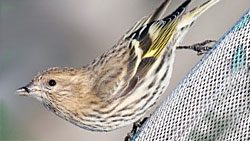Do Siskins Move in Straight Lines?
By Hugh Powell September 30, 2010

The winter of 2008-2009 was a huge year for Pine Siskins across the United States. As the dainty yellow-and-brown finches poured across the country, sightings from Project FeederWatch participants documented one of the largest siskin irruptions on record. Now, a preliminary analysis of banding data by FeederWatch leader David Bonter suggests the birds may have moved according to just a few clear patterns.
Every few years, Pine Siskins breeding in northern North America move far to the south of their typical winter range in what’s called an irruption. (Several finch species do this, and it’s thought to be a response to changing regional seed crops.) Licensed bird-banders caught more than 30,000 siskins in the 2008-2009 winter, and Bonter had the idea to check records to see how many of the banded birds had been recovered since then, and where.
It turns out 46 siskins banded that winter had been recovered and reported to the North American Bird Banding Lab. But when Bonter compared where each bird was banded and where it was found, he was astounded by what he saw. Birds that wintered in the southern states had returned nearly due north to breed; whereas birds banded in the northeast during winter had flown nearly due west to places like Oregon, Washington, and Alberta, Canada.
The pattern is striking—suggesting that siskins may move systematically according to two very different strategies depending on where they have bred. But Bonter cautions it’s only 46 birds so far—he has since requested fuller records from additional years to investigate the pattern further. I take it as a great example of both scientific curiosity and the power of citizen-science (both banding stations and Project Feederwatch) to bring those patterns into relief.
Did I mention the next season of Project FeederWatch starts up in November? Sign up and be a part of 2010-2011 discoveries!
For a fuller explanation of Bonter’s work, maps of the irruption and band recoveries, and more information about how to report banded birds, see the FeederWatch news article.


All About Birds is a free resource
Available for everyone,
funded by donors like you




